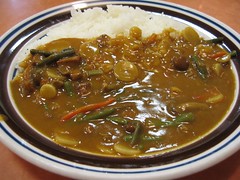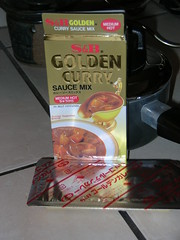
I don't know about you, but curry has always been a comfort food for me. When you are a long way from home in strange place it's important to have something that fills you up and makes you feel warm inside. Japanese curry may not have the same kick as a vindaloo, but it sure hits the spot on a cold winter night.

As is the case with many things that are imported into Japan, curry has been adapted to suit Japanese tastes and fashions. Curry Rice (カレーライス) is nothing like a traditional Indian or Pakistani curry; it's not as hot, sometimes it's a little sweet and it 's always served on a bed of rice.
In my experience a lot of expats in Japan get stuck in the fast food rut for breakfast, lunch and dinner. They either won't cook for themselves or can't find anything they like in the supermarket (which I find hard to believe). There are so many alternatives to the food-that-isn't-really-food you find at Macca's and Burger King.
Even if you don't live in Japan, Japanese curry mixes can be found in Asian supermarkets, or Supermarkets with a Japanese food section. Have you found any in your neighbourhood?
 Curry is pretty easy to make, and it's something you can begin to take pride in if done well. If you make enough and store it properly it tastes even better the next day, perfect for when you don't feel like making lunch.
Curry is pretty easy to make, and it's something you can begin to take pride in if done well. If you make enough and store it properly it tastes even better the next day, perfect for when you don't feel like making lunch.There are three ways to enjoy a Japanese curry, made from scratch, from a ready made roux, or at any one of the many curry houses found in Japan. I'm not going to repeat any recipes here today, you know "you can feed a man a fish, and he'll eat for a day, or you can teach him how to fish..."
What I want to do is pull together few resources to introduce you to wonder of curry rice.
Making curry raisu from scratch
You would have to be pretty keen to start from scratch, since there are so many good curry powders on supermarket shelves. But if you have time to hunt for the right ingredients, and the patience to get proportions right here are a few starting tips.
You'd think the maker of one of the most popular curry powders on the Japanese market, S&B Foods (e-エスビーフーズ), would want to keep their secret safe, but their ingredients can be found on the side of the tin. I've found S&B Curry at a Korean supermarket, you could do the same. In Australia, importers are required by law to label food in English, so there is no need to get the dictionary out.
You don't need to go to the trouble of doing the translation either (not unless you want to, it's good practice) because Maki has translated the formula for making S&B curry powder at her site Just Hungry.
If you follow Maki's instructions, they provide a good base from which to start experimenting. Once you've made the curry powder, you can just follow one of the many recipes that are out there on teh interwebs.
Here are the original instuctions for making S&B curry powder at the Rakuten Ichiba (【楽天市場】カレー粉の作り方:e-エスビーフーズ)

Making curry rice from roux
The first place I look for Japanese recipes is Cookpad (クックパッド). Cookpad has almost half a million user generated recipes, and 423 for curry rice (カレーライス のレシピ 423) The site is pretty good for searching and saving good recipes to your 'kitchen', but it doesn't seem to have any social tools, I guess they come with the premium service.
 If you have a roux the process is pretty simple, and involves sautéeing chopped vegetables and meat in oil until the onions are translucent and the meat is browned. Japanese roux is generally sweetened with apple, and it thickens a little like gravy. The curry mix is added after the meat and other ingredients have been simmered on a low heat for about 2o minutes.
If you have a roux the process is pretty simple, and involves sautéeing chopped vegetables and meat in oil until the onions are translucent and the meat is browned. Japanese roux is generally sweetened with apple, and it thickens a little like gravy. The curry mix is added after the meat and other ingredients have been simmered on a low heat for about 2o minutes.
Curry rice is served on a flat plate, half filled with short grain rice. There are sorts of things that are addeded to the dish to finish it off; boiled egg, pickled ginger, or fermented soy beans (納豆), just to name a few.
I'm no expert at cooking curry rice, so if you feel you need a little more guidance Maki makes a mean Japanese beef curry.
Visiting a curry house in Japan
If you are travelling in Japan, eating something vaguely resembling western food can be kind of reassuring. Japanese curry, the way they make it in Japan, can usually only be found in Japan, so it's worth trying while you are there. One of the most famous curry houses, CoCo Ichibanya (カレーハウスCoCo壱番屋), has recently opened stores in China, Korea, Taiwan, Thailand, and Hawai'i.

If you're worried about being able to read the menu, CoCo Ichibanya has a Multilingual menu book . You shouldn't be too intimidated even if you can't find a CoCo Ichi, a lot of Japanese curry houses have a "point and shoot menu" with plastic food in the windows.
Hmm, plastic food...

So there you have it. There are many ways to enjoy the experience of Japanese curry rice, all it takes is a little sense of adventure.
Do you have a favourite style of curry rice? What are some of the craziest toppings you've tried? Does any one remember the competition they used to have at CoCo Ichi for the largest serving, something like, if you could eat it within a certain time you got it free? Can any one confirm this for me?
All of this blogging about food has made me hungry again.


